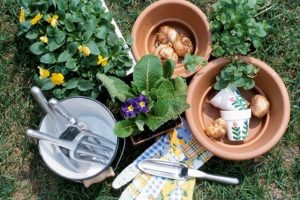Why would someone want to grow seeds? There are thousands of transplants available in retail nurseries. What is the difference? First and foremost, the varieties in that stack of seed catalogs are never ending. There are varieties that will deal with your climate, soil, bad bugs, and be completely different from anything you have ever tried. You will have the opportunity of earlier, or in case of bad weather, later plantings. When you grow your own plants you will control their destiny and timing. Their root systems will be strong and the plants will be healthier. Growing your own plants from seed is also cost effective. You will have better varieties with healthier plants with less money out of your pocket. When you consider plants that produce your food the savings are great compared to grocery store prices.
How do you get started? To be successful you will need a medium or seed starting soil, containers, and a way to keep the temperature constant during germination, moisture, and light. Depending on the type of seed the requirements will vary.
Your medium should be sterile. There are soils just for seed starting, or use a clean, new potting soil. Pre-moisten the soil and fill your containers. The containers may be trays or growing trays with individual cells. You do not want the containers to be too large, it is better to move your plants up as the roots develop and fill the pot. Your plants will prefer a soil mixture that has 50% soil, 25% air space for oxygen, and 25% moisture. The soil should drain but maintain moisture.
The temperature for germination is 70 to 75 degrees. Check your seed packet for complete information. If you are using florescent lights close to the soil, they will warm the soil enough for germination. Usually 3 to 4 inches away from the soil material is best to start. Some people use the top of the refrigerator, window sills, or heating mats. Some seeds need cool temperatures so those seeds will germinate in your unheated garage or enclosed porch.
Seeds need moisture to germinate. Humidity and moisture must be controlled; too much water the seed rots, too little water the seed refuses to germinate. The soil must be kept evenly moist but not soaking wet.
Light is equally as important as all the other variables. Knowing what the requirements are for your individual type of seed will create a successful germination. After the seeds have germinated they need sufficient light to grow strong. Florescent lights are best for the demands of seedlings. Plants do need time with the lights off to rest. After germination occurs your lights should be on 12 to 14 hours a day. As the plants mature you will continue to move the lights upward.
The last process before transplanting your seedlings into the garden is to harden them off by giving them time outdoors. Hardening off takes the baby plant and introduces them to outside elements by acclimating them to temperatures, sunlight, and wind. Start slowly in the shade or light morning sun and gradually add more sunlight. Be mindful of pests that might want to enjoy a meal on those tender shoots, pest like earwigs, slugs, and snails.
There are many websites and books that will help you starting out. If you would like to talk to a master gardener, stop by the Sonora Library and visit the Seed Library. They are open Saturdays 10:00 to 2:00 starting in March through October. The Seed Library will give you three packets of seeds, information, and advice for growing your plants. Enjoy the bounty, and return the seeds at the end of the season. Come by and chat with people that love playing in the dirt.
Julie Silva is a University of California Cooperative Extension Master Gardener of Tuolumne County.


